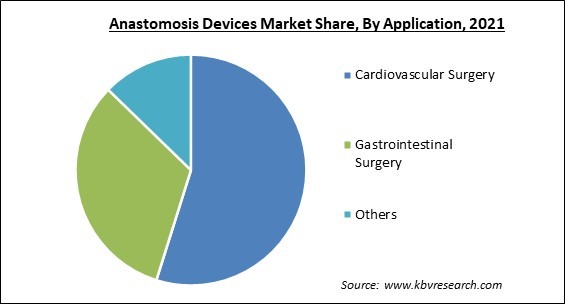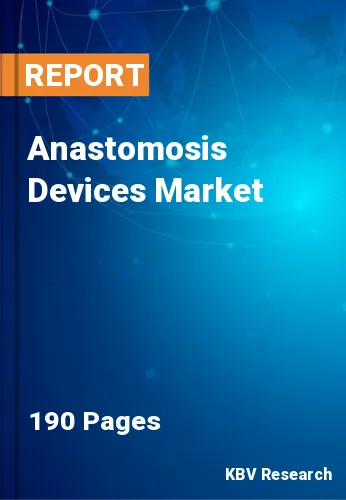The Global Anastomosis Devices Market size is expected to reach $4.8 billion by 2028, rising at a Market growth of 5.5% CAGR during the forecast period.
A connection between cavities or passages that ordinarily branch or diverge, such as blood arteries, leaf veins, or streams, is called an anastomosis. Vascular and gastrointestinal anastomosis are the most prevalent types of anastomosis. Vascular anastomosis is the link of a graft to a blood vessel to build a bypass during heart bypass surgery. During bowel excision, a gastrointestinal anastomosis is done, in which the physician sutures or staples the two terminals of the intestine together. Anastomosis devices are easy to use and reduce the need for surgery, which is a key component in evaluating long-term success. The anastomosis is critical because it connects the graft vessels to the target vessels, and any distortion can cause flow restriction. As a result, anastomotic instruments are now available for endoscopic or minimally invasive use, enabling smaller incisions and fewer cardiac surgeries.
The anastomosis Market is primarily driven by a rise in the instances of cardiovascular surgeries conducted, as well as an increasing prevalence of chronic conditions such as cardiac ailments and gastrointestinal disorders. Cardiovascular diseases are one of the most common causes of death all over the world. As per the World Health Organization, 17.9 million people lost their lives due to cardiovascular illnesses in 2019, accounting for almost 32% of all fatalities worldwide. Moreover, 85 percent of these deaths were caused by heart attacks and strokes. In the coming years, this will very certainly raise demand for anastomosis devices. As a result, more research and developments activities are being done on anastomosis device innovation in order to improve clinical outcomes clinical outcomes.

The COVID-19 pandemic caused a severe impact on various economies all over the world. Several businesses were significantly devastated as a result of the outbreak of the COVID-19 infection. In addition, the governments of several countries were forced to impose lockdowns in their nations. As a result, the manufacturing units of numerous goods were temporarily shut down. Moreover, these lockdowns also caused a major disruption in the supply chain of various goods. Further, COVID-19 led the worldwide healthcare industry to a significant failure due to the shortage of beds and oxygen in hospitals.
The Market is anticipated to expand as the number of myocardial infarctions rises. In surgical procedures, anastomosis devices are essential. As the prevalence of chronic diseases rises, the demand for anastomosis devices would also proportionally rise, propelling the sector forward. Technologically complex anastomosis systems can help to reduce the hazards associated with surgical procedures. Lesser operating time, more flexibility for surgeons, reduced anesthetic exposure, and a lesser danger of blood leakage are all factors that are increasing the demand for anastomosis devices in various hospitals and other healthcare facilities all over the world.
Minimally invasive surgery is a type of surgery that uses small incisions rather than a large incision in order to complete the surgical process. These kind of surgeries have a number of benefits, including smaller incisions, faster recovery, lesser pain, and a shorter hospital stay. Surgeons make small incisions in the skin, usually a few millimeters long, in minimally invasive surgery. An endoscope, a long and thin tube with a camera, is then inserted into one of the incisions. Images from the endoscope are projected onto monitors in the operating room, allowing surgeons to see crisp, enlarged images of the surgical site.
Anastomosis devices are the latest innovation in the healthcare sector. However, these devices have very high prices, which becomes challenging for several developing or under-developed nations to employ these devices in their healthcare facilities. The high price of these devices is owing to the constantly increasing prices of surgical procedures in healthcare institutions all over the world. Because of the high price of anastomosis devices people are being deprived of the benefits of these devices. Moreover, operating an anastomosis device requires high precision and skills, due to which, there is an immense requirement of professional and experienced surgeons in order to leverage this instrument.

Based on Product Type, the Market is segmented into Disposable and Reusable. In 2021, the disposable segment acquired the largest revenue share of the anastomosis devices Market . The growth of this segment is owing to the wide range of disposable anastomotic products available in the Market along with the increased Market penetration of these devices. In addition, the majority of major Market players are involved in the manufacture of throwaway goods, which is leading the Market to a robust supply chain of these goods. Moreover, Surgical Site Infections, cross-contamination, as well as other Healthcare-Associated Infections are all being significantly reduced by leveraging these products. Another benefit of disposable anastomotic device over reusable one is that they do not need to be reprocessed between usage, lowering reprocessing costs along with speeding up the procedure. Because of these advantages, the growth of this segment is being augmented.
Based on Application, the Market is segmented into Cardiovascular Surgery, Gastrointestinal Surgery and Others. In 2021, the Gastrointestinal Surgery segment recorded a substantial revenue share of the anastomosis devices Market . Due to the rising incidences of colorectal cancer as well as other gastrointestinal disorders that necessitate bowel resection, the gastrointestinal surgery segment, which includes large bowel resections and colorectal surgeries, is being majorly increased. This is owing to the constantly evolving lifestyles of people all over the world.
Based on End User, the Market is segmented into Hospitals and Ambulatory Care Centers & Clinics. In 2021, the Hospitals segment registered the maximum revenue share of the anastomosis devices Market . Hospitals provide better treatment to patients, resulting in lucrative growth. According to the American Heart Association, the number of in-patients due to cardiovascular disease would nearly double by 2030, to approximately 23.6 million. Moreover, various variables such as an increase in the number of patients visiting hospitals as a result of good reimbursement and easy access to treatment are propelling the industry forward.
| Report Attribute | Details |
|---|---|
| Market size value in 2021 | USD 3.4 Billion |
| Market size forecast in 2028 | USD 4.8 Billion |
| Base Year | 2021 |
| Historical Period | 2018 to 2020 |
| Forecast Period | 2022 to 2028 |
| Revenue Growth Rate | CAGR of 5.5% from 2022 to 2028 |
| Number of Pages | 190 |
| Number of Tables | 330 |
| Report coverage | Market Trends, Revenue Estimation and Forecast, Segmentation Analysis, Regional and Country Breakdown, Companies Strategic Developments, Company Profiling |
| Segments covered | Product Type, Application, End User, Region |
| Country scope | US, Canada, Mexico, Germany, UK, France, Russia, Spain, Italy, China, Japan, India, South Korea, Singapore, Malaysia, Brazil, Argentina, UAE, Saudi Arabia, South Africa, Nigeria |
| Growth Drivers |
|
| Restraints |
|
Based on Regions, the Market is segmented into North America, Europe, Asia Pacific, and Latin America, Middle East & Africa. In 2021, North America accounted for the largest revenue share of the anastomosis devices Market and is estimated to continue this trend over the forecast period. The rising frequency of cardiovascular illnesses, as well as the escalating number of R&D collaborations amongst leading companies in the region, are playing a major role in the rising development of this segment. Additionally, increasing access to medical help, increased knowledge of CHD and CVD, increasing disposable income, and a well-established R&D infrastructure are all contributing to the growth of the regional Market .
Free Valuable Insights: Global Anastomosis Devices Market size to reach USD 4.8 Billion by 2028
The Market research report covers the analysis of key stake holders of the Market . Key companies profiled in the report include Medtronic PLC, LivaNova PLC, Becton, Dickinson and Company, Johnson & Johnson, Peters Surgical, Smith & Nephew PLC, Boston Scientific Corporation, B. Braun Melsungen AG, ConMed Corporation, and Baxter International, Inc.
By Product Type
By Application
By End User
By Geography
The global anastomosis devices market size is expected to reach $4.8 billionn by 2028.
Increasing number of surgical procedures are increasing are driving the market in coming years, however, high price and the requirement of professional operators growth of the market.
Medtronic PLC, LivaNova PLC, Becton, Dickinson and Company, Johnson & Johnson, Peters Surgical, Smith & Nephew PLC, Boston Scientific Corporation, B. Braun Melsungen AG, ConMed Corporation, and Baxter International, Inc.
The Cardiovascular Surgery segment acquired maximum revenue share in the Global Anastomosis Devices Market by Application 2021, thereby, achieving a market value of $2.5 billionn by 2028.
The North America is the fastest growing region in the dominated the Global Anastomosis Devices Market by Region 2021, and would continue to be a dominant market till 2028.
Our team of dedicated experts can provide you with attractive expansion opportunities for your business.

